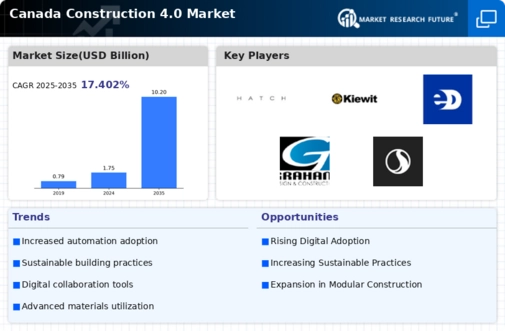Skilled Labor Shortages
The construction 4-0 market is currently facing challenges related to skilled labor shortages. As the industry evolves with new technologies, there is a pressing need for workers who are trained in advanced construction techniques and digital tools. In Canada, it is estimated that the construction sector will require an additional 300,000 skilled workers by 2025 to meet growing demand. This shortage may hinder project timelines and increase labor costs, prompting companies to invest in workforce development initiatives. Addressing this issue is crucial for the sustained growth of the construction 4-0 market.
Rising Demand for Smart Buildings
The demand for smart buildings is reshaping the construction 4-0 market in Canada. As urbanization continues, there is a growing need for buildings that are energy-efficient, sustainable, and equipped with advanced technologies. Smart buildings utilize IoT devices to optimize energy consumption and enhance occupant comfort. According to recent studies, the market for smart building technologies is projected to grow by 25% annually in Canada. This trend not only reflects changing consumer preferences but also drives innovation within the construction sector, pushing companies to adopt smart solutions in their projects.
Government Infrastructure Investments
Government investments in infrastructure are a critical driver for the construction 4-0 market. In Canada, the federal government has committed over $180 billion to infrastructure projects over the next decade, focusing on transportation, green energy, and urban development. This funding is expected to create thousands of jobs and stimulate economic growth. The emphasis on modernizing infrastructure aligns with the goals of the construction 4-0 market, as it encourages the adoption of innovative construction methods and technologies. As these projects roll out, they will likely enhance the overall market landscape.
Sustainability Regulations and Standards
Sustainability regulations are increasingly influencing the construction 4-0 market. In Canada, various provinces have implemented stringent building codes aimed at reducing carbon emissions and promoting energy efficiency. These regulations compel construction firms to adopt sustainable practices, such as using eco-friendly materials and implementing waste reduction strategies. The Canadian government has set ambitious targets to reduce greenhouse gas emissions by 40-45% by 2030, which directly impacts the construction industry. Compliance with these standards not only enhances a company's reputation but also opens up new market opportunities.
Technological Advancements in Construction
The construction 4-0 market is experiencing a surge in technological advancements, particularly in automation and robotics. These innovations are streamlining processes, reducing labor costs, and enhancing safety on job sites. For instance, the integration of Building Information Modeling (BIM) has improved project visualization and collaboration among stakeholders. In Canada, the adoption of drones for site surveys and inspections has increased by approximately 30% over the past year, indicating a strong trend towards embracing technology. This shift not only boosts efficiency but also positions companies to compete effectively in a rapidly evolving market.
















Leave a Comment